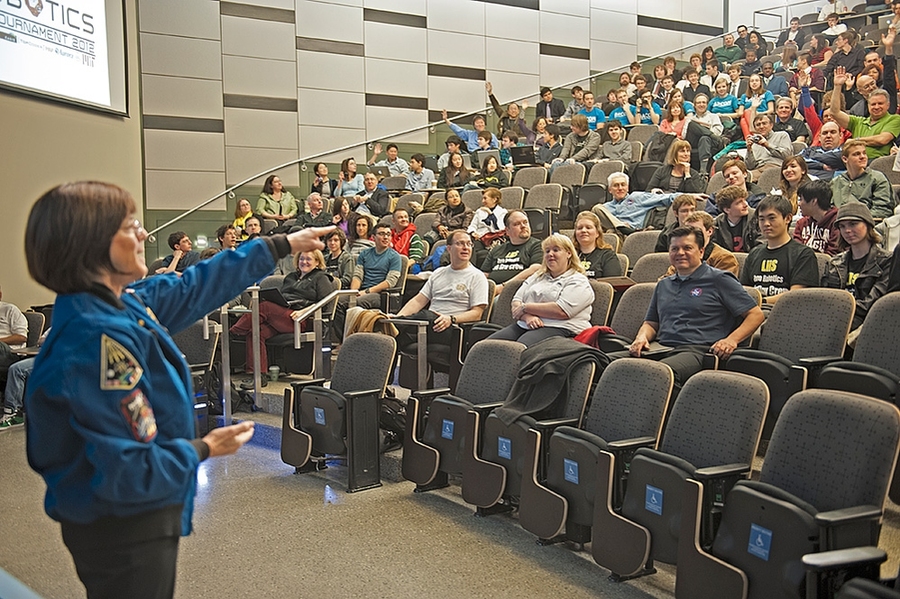What’s it like to operate satellites 260 miles above the Earth’s surface? Now more than 200 high-school students can tell you from experience — and add the engineering feat to their college applications.
Last week, MIT’s Department of Aeronautics and Astronautics (AeroAstro) hosted its annual Zero Robotics tournament, in which high-school students from the United States and Europe developed computer codes to direct small basketball-sized satellites aboard the International Space Station (ISS).
This year, more than 1,700 students from around the world joined the challenge, with some programming for the very first time. Over the course of three months, teams of students worked out computer codes to steer the satellites through a series of maneuvers, completing a virtual “mission” — clearing lower Earth’s orbit of accumulating space junk.
Students put their codes to the test in online simulations, gaining points over opponents by completing certain maneuvers. After a series of simulation rounds, the field eventually whittled to 200 finalists from the United States and Europe; these students gathered last Friday at MIT, and the European Space Research and Technology Center in the Netherlands, to watch their codes at work in space.
Through a live video downlink from the ISS, students watched as astronaut Thomas Marshburn and commander Kevin Ford prepared the satellites for competition. The satellites — one red, the other blue — are the latest version of SPHERES (Synchronized Position Hold, Engage, Reorient Experimental Satellites), small programmable probes first conceived of by MIT undergraduates and further developed by MIT’s Space Systems Laboratory. Since 2006, the satellites have served as experimental software platforms on the ISS.
As the astronauts made sure the satellites were properly fueled — the probes run on puffs of carbon dioxide — teams at MIT and at NASA’s Ames Research Center in California uploaded the students’ codes to the ISS.
“It boggles my mind,” Marshburn told the students as he prepared the satellites. “The level of education today has come very far from my days in school … we can feel the brainpower down there.”
The competition took place in the Japanese Experiment Pressurized Module, a short corridor in which astronauts conduct microgravity experiments. At the start of each round, Marshburn and Ford aligned the satellites at one end of the module. Each satellite slowly made its way to the other end, autonomously following instructions from students’ codes. A team gained points with certain maneuvers, such as rendezvousing or docking with various points in the module.
By programming a satellite to perform such maneuvers, teams were essentially learning to simulate actions that a real orbiting satellite might make in space — skills essential to pushing aerospace engineering forward, according to competition organizer Alvar Saenz-Otero.
“We’re beginning to create this big group of programmers that will help us move forward,” Saenz-Otero told students assembled in an MIT auditorium. “Hopefully, ideas you came up with will inspire folks at NASA to develop new ideas.”
The competition was interrupted at intervals by drops in the video and audio feeds, and at times the astronauts had to pause to replace the satellites’ carbon dioxide tanks. When the championship round between the two top U.S. teams yielded a rather anemic bout — both satellites came up short on points — Marshburn and Ford refueled both tanks and reran the students’ codes, with a higher-scoring and more dramatic finish.
“That was a very aggressive last run,” Ford reported, to cheers from the MIT auditorium. “We could tell a full load of gas really made a difference.”
The winning U.S. team comprised students from three high schools: Mira Loma High School in Sacramento, Calif., Montclair High School in Montclair, N.J., and Evergreen School District in Vancouver, Wash. The winning European team included students from Berlin and Padova, Italy.
As a last piece of advice before signing off from the ISS, Ford told the students, “There’s always a few obstacles in the way of everything, and you just have to keep working through them. Keep going after those science and engineering degrees. It helps to understand so much of this planet better.”
200 high-school students participate in MIT’s annual Zero Robotics competition.
Publication Date:

Caption:
Teams of students watched from MIT's 10-250 auditorium, as astronauts aboard the International Space Station monitored the small, basketball-sized satellites.
Credits:
Photo: Bill Litant

Caption:
Astronaut Barbara Morgan talked to Zero Robotics finalists about her experience aboard the Space Shuttle.
Credits:
Photo: Bill Litant





